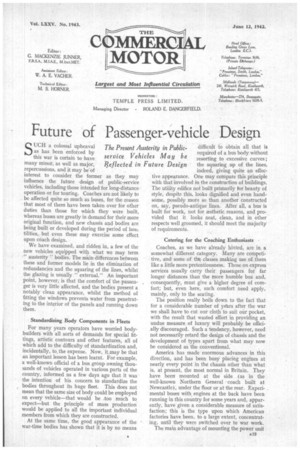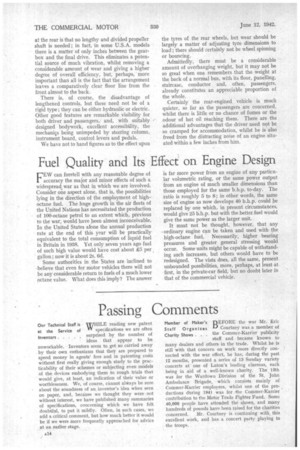Future of Passenger-vehicle Design
Page 15

Page 16

If you've noticed an error in this article please click here to report it so we can fix it.
SUCH a colossal upheaval as has been enforced by this war is certain to have many minor, as well as major, repercussions, and it may be of interest to consider the former as they may influence the future design of public-service vehicles, including those intended for long-distance operation or for touring. Coaches are not likely to be affected quite so much as buses, for the reason that most of them have been taken over for other duties than those for which they were built, whereas buses are greatly in demand for their more original function, and new chassis and bodies are being built or developed during the period of host tilities, but even these may exercise some effect upon coach design.
We have examined, and ridden in, a few of the new vehicles equipped with what we may term • " austerity " bodies. The main differences between these and former models lie in the elimination of redundancies and the squaring of the lines, whilst the glazing is usually " external." An important point, however; is that the comfort of the passenger is very little affected, and the bodies present a notably clean appearance, whilst the method of fitting the windows prevents water from penetrating to the interior of the panels and running down them.
Standardizing Body Components in Fleets For many years operators have worried bodybuilders with all sorts of demands for special fittings, artistic contours and other features, all of which add to the difficulty of standardization and, incidentally, to, the expense. Now, it...may be that an important lesson has been learnt. For example, a well-known official of a bus group owning thousands of vehicles operated in various parts of the country, informed us a few days ago that it was the intention of his concern to standardize the bodies throughout its huge fleet. This does not mean that the same size of body could be employed on every vehicle—that would be too much to expect—but the principle of mass production would be applied to all the important individual members from which they are constructed.
At the same time, the good appearance of the war-time bodies has shown that it is by no means difficult to obtain all that is required of a bus body without resorting to excessive curves; the squaring up of the lines, indeed, giving quite an effective appearance. One may compare this principle with that involved in the construction of buildings. The utility edifice not built primarily for beauty of style, despite this, looks dignified and even handsome, possibly more so than another constructed on, say, pseudo-antique lines. After all, a bus is built for work, not for aesthetic reasons, and provided that it looks neat, clean, and in other respects well groomed, it should meet the majority of requirements.
Catering for the Coaching Enthusiasts Coaches, as we have already hinted, are in a somewhat different category. Many are competitive, and some of tht classes making use of them like a little more pretentiousness. Those on express services usually carry their passengers for far longer distances than the more humble bus and, consequently, must give a higher degree of comfort; but, even here, such comfort need apply, mainly, only to the seating. The position really boils down to the fact that for a considerable number of yekrs after the war we shall have to cut our cloth to suit our pocket, with the result that wasted effort in providing an undue measure of luxury will probably be officially discouraged. Such a tendency, however, need not necessarily retard the design of chassis and the development of types apart from what may now be considered as the conventional.
America has made enormous advances in this direction, and has been busy placing engines at nearly every point in the chassis other than what is, at present, the most normal in Britain. They have been mounted at the side (as in the well-known Northern General coach built at Newcastle), under the floor or at the rear. Experimental buses with engines at the back have been running in this country for some years and, apparently, have given a considerable measure of satisfaction; this is the type upon which American factories have been, to a large extent, concentrating, until they were switched over to war work.
The main advantage of mounting the power unit at the rear is that no lengthy and divided propeller shaft is needed ; in fact, in some U.S.A. models there is a matter of only inches between the gearbox and the final drive. This eliminates a potential source of much vibration, whilst removing a considerable amount of wear and giving a higher degree of overall efficiency, but, perhaps, more important than all is the fact that the arrangement leaves a comparatively clear floor line from the front almost to the back.
There is, of course, the disadvantage of lengthened controls, but these need not be of a rigid type ; they can be either hydraulic or electric. Other good features are remarkable visibility for both driver and passengers, and, with suitably designed bodywork, excellent accessibility, the mechanics being unimpeded by steering column, instrument board, control levers and pedals.
We have not to hand figures as to the effect upon the tyres of the rear wheels, but wear should be largely a matter of adjusting tyre dimensions to load ; there should certainly not be wheel spinning or bouncing.
Admittedly, there must be a considerable amount of overhanging weight, but it may not be so great when one remembers that the weight at the back of a normal bus, with its floor, panelling, staircase, conductor and, often, passengers, already constitutes an appreciable proportion of the whole.
Certainly the rear-engined vehicle is much quieter, so far as the passengers are concerned, whilst there is little or no chance of fumes or the odour of hot oil reaching them. There are the additional advantages that the driver need not be so cramped for accommodation, whilst he is also freed from the distracting noise of an engine situated within a few inches from him.




















































